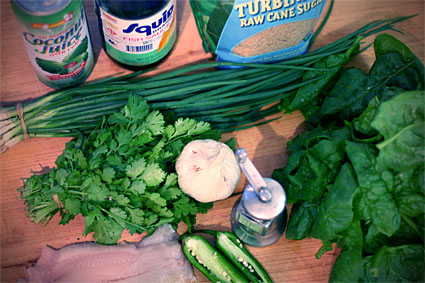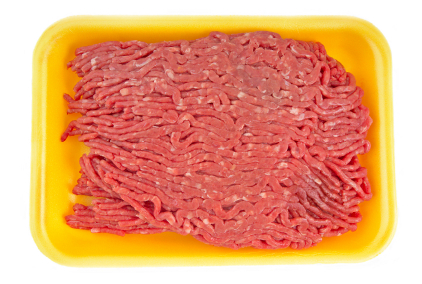 The addition of spring greens makes this Vietnamese-style caramelized catfish a complete meal.(April McGreger photos)
The addition of spring greens makes this Vietnamese-style caramelized catfish a complete meal.(April McGreger photos)
Recently I visited my family in Mississippi, where I dodged tornadoes and lamented flooded fields of corn and soybeans and the many farmers who’ve gone bust. The one thing that distracted us from the immediate crises in the northern half of the state was the abominable news coming from our neighbors to the south. The television constantly blasted updates on the Gulf oil spill — the consequences of which we found hard to fathom, when so many residents are still barely hanging on from Katrina.
The region seems more insecure and unsettled than any other time in my memory. Farmers are baffled by the severe weather of recent years and the new diseases that have led to three consecutive bad harvests. Fishermen and the entire tourism industry of the Gulf States are on the brink of bankruptcy. Many families are reconsidering their summer beach trips and wondering if they’ve enjoyed their last Gulf shrimp and oysters for a while. In these instances, people are personally experiencing the environmental destruction caused by reckless pursuit of short-term corporate profits over safety and long-term environmental and economic health.
I see potential here. The time is ripe to usher in the era of Southern environmentalism. Who’s in charge of protecting the environment that is our greatest resource? Whether it is coal fields, timber forests, fertile farmland, or our incredibly rich Gulf, the South’s natural resources have always been the basis of our economy. When those resources are not handled responsibly, economic disaster is inevitable.
These disasters provide us an opportunity to focus on how we can support healthy oceans, healthy farmland, and their subsequent economies sustainably. The South has historically been weak in its environmental activism. Forbes issued a ranking of America’s “greenest states” three years ago: Mississippi, Alabama, and Louisiana were in the bottom five. So how do we channel these current widespread feelings of vulnerability and insufficient government protections into action? According to Gil Rogers of the Southern Environmental Law Center, there is an environmental movement now growing in South, and it is unique. At the state and local level, alliances are forming between conservative Republicans, hunters, and environmentalists. These environmental activists are often motivated by a personal connection to a piece of land that they have seen decimated in their lifetimes.
The first thing that we can do is demand that the Obama administration call a halt to offshore drilling immediately. As Derb Carter, director of the Carolinas office at the Southern Environmental Law Center, says, “The only proven approach that protects our coastlines from oil spills is not to drill. It’s a painful lesson to relearn each time spills happen, and hard-working people and productive coastal areas bear the brunt of lasting effects. As we’re unfortunately witnessing now, it only takes one oil spill — regardless of cause — to devastate the beauty, rich cultural traditions, communities, and fisheries and wildlife of a coast for years.”
Next, we must insist that money is invested in developing green energy, which will provide both increased economic and national security. This is the least costly and most environmentally friendly solution to our current energy crisis, along with curbing demand through increased energy efficiency and conservation.
It is too early to tell just how badly the spill will affect the Gulf fishing industry, but Jacqueline Savitz of Oceana told the Washington Post that the spill poses a threat to the safety of eating fish and shellfish for many years to come, since oil-based contaminants are known to accumulate in the food chain, along with their associated elevated cancer and neurological risks. (Then there’s the problem of the clean-up chemicals possibly being worse than the oil itself, as Tom Philpott has explored here.) Hopefully, the spill can be contained before the entire Gulf fishing and shrimp industry faces economic collapse.
In the meantime, we can sate our cravings for seafood with responsibly farmed and environmentally friendly, U.S. farm-raised catfish. The Monterey Bay Aquarium lists U.S. farm-raised catfish as a Best Choice on its Seafood Watch list, and Grist’s Lou Bendrick has previously explored catfish’s pros and cons in depth.
 Everything you need for this sweet and savory dishIn this recipe, I’m tipping my hat to the large Vietnamese-fishing communities on the Mississippi and Louisiana coasts, some of whom will bear the brunt of this disaster for years to come. Let’s remember them and the rest of the fishing community when we’re holding BP accountable for the damage done. (Southern Foodways Alliance has a terrific oral history collection of Biloxi’s ethnic shrimping communities.)
Everything you need for this sweet and savory dishIn this recipe, I’m tipping my hat to the large Vietnamese-fishing communities on the Mississippi and Louisiana coasts, some of whom will bear the brunt of this disaster for years to come. Let’s remember them and the rest of the fishing community when we’re holding BP accountable for the damage done. (Southern Foodways Alliance has a terrific oral history collection of Biloxi’s ethnic shrimping communities.)
Vietnamese-style Caramelized Catfish
Serves 3-4
This dish is traditionally made in a clay pot, and I highly recommend them. However, it is equally delicious when cooked in an enameled cast iron or other heavy-duty pot. This is a quick and easy weeknight dish, but definitely special enough for company. I couldn’t resist adding some tender spring greens, in this case spinach, to make it a complete meal along with some steamed rice. A cool and refreshing cucumber-mint salad would be delicious alongside. For a vegetarian version, substitute Japanese eggplant, tofu, tempeh, or even portobello mushrooms for the catfish, and two tablespoons tamari soy sauce for the fish sauce.
Note that the sauce for this dish is intensely flavored and meant to be served with unseasoned rice. If you are salt-shy, you can reduce the fish sauce called for to two tablespoons.
2 tablespoons palm sugar or raw cane sugar (such as turbinado)
1 tablespoon vegetable oil
2 shallots, peeled and thinly sliced
1 garlic clove, minced
1 Serrano pepper, or jalapeño cut in half lengthwise (optional)
½ cup water or coconut water (not coconut milk!)
3 tablespoons fish sauce
12 ounces catfish fillets, cut into 1-inch-wide strips
4 scallions, cut into 1-inch-long pieces
Handful of cilantro leaves (optional)
2 cups fresh spinach leaves (optional)
½ teaspoon freshly ground black pepper
In a heavy bottomed, non-reactive pot, place the sugar and ¼ cup of the water. Cover with the lid and bring to a boil over high heat. After a few minutes remove the lid and continue cooking until the sugar begins to burn. It will smell burnt and should just begin to smoke. (Burning the sugar is what gives this dish its incredible smoky flavor, so don’t be afraid!)
Immediately add the sliced shallots, garlic, and the Serrano pepper. Toss to coat with the caramel, then quickly add the water, fish sauce, and the catfish filets. Turn the catfish to coat with the sauce, then cover the pot and cook over medium heat for 5 minutes.
Uncover and cook for 2-3 more minutes, until the sauce has thickened.
Take the pan off heat and add the scallions, cilantro, spinach, and black pepper. Toss to coat with the sauce and serve immediately with steamed rice.




